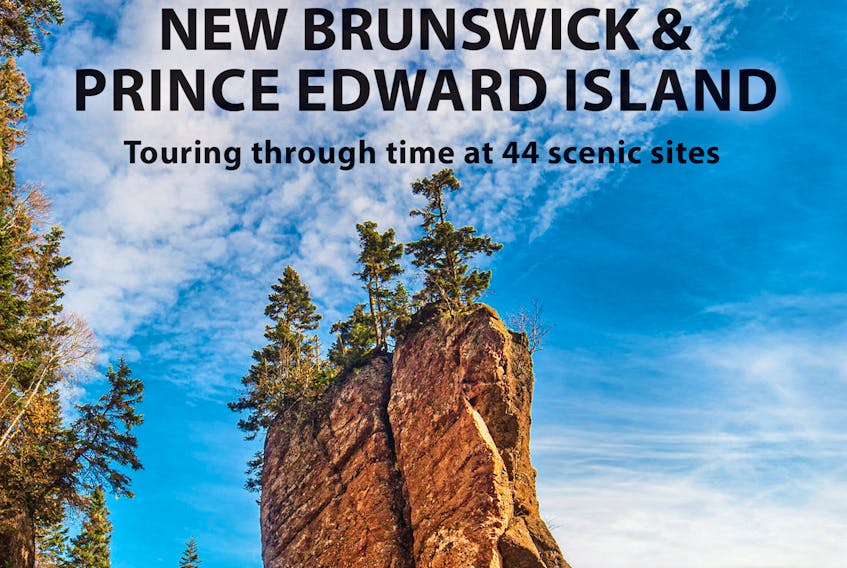In this summertime of the Atlantic Bubble, it behooves us to learn more about our neighbours. This book considers two of our partnering provinces together, with the material divided into four geographical sections: Fundy West, Fundy East, Northwest and Northeast.
“In New Brunswick and Prince Edward Island, nature paints with bold strokes: high mountains, long rivers, rushing tides, endless beaches,” co-authors Martha Hickman Hild and Sandra M. Barr write in their preface. “Underlying the landscape — shaping the land and its history — is solid bedrock, the subject of this book.
“The bedrock itself speaks boldly, too. If you spend a bit of time exploring the rocks here, along with great scenery you’ll find dramatic stories of the geologic past.”
The 44 sites explored in the volume were selected “with families and the casual traveller in mind.”
The book is laid out to be crisply visually instructive. Colour-coded by location, and set with full coloured scenic photos, other features include “non-technical descriptions,” GPS waypoints, thumbnail maps, road maps, additional details and resources, and a “timeline showing the site’s place in geologic time.”
“In New Brunswick and Prince Edward Island, nature paints with bold strokes: high mountains, long rivers, rushing tides, endless beaches.” — Martha Hickman Hild and Sandra M. Barr
This is followed by “Geology Basics,” giving the reader a ground-floor introduction to topics like superposition (“sedimentary rocks are deposited in horizontal layers, with younger layers on top of older layers”), fossil species, radiometric data, and a breakout of the colour-gradient timeline, its palette spanning four eons (“Cryogenian”; “Triassic”). It describes and contrasts sedimentary, igneous, and metamorphic rocks, explains plate tectonics, helps one discern one’s terranes from one’s basins, and gives a big picture overview of the region. It also has a trip planner broken out region by region, which thoughtfully includes scenic drives and the length of hikes.
All that before the first entry, Todd’s Point, N.B.
Subtitled “Champlain’s Bubbles: Magma Mingling in a Silurian Intrusion,” the narrative begins: “The year was 1604, as any Canadian schoolchild knows, when a French expedition including explorer Samuel de Champlain sailed up the Bay of Fundy and into the St. Croix River. … To honour Champlain’s presence centuries ago, park naturalists gave the name ‘Champlain’s Bubbles to a tide-related effect that sometimes appears in the water below Ganong Cottage. But the name could equally be applied to nearby rock outcrops. Along the shore, a process known to geologists as magma mingling is preserved in sharp detail on the wave-washed rocks.”
“Getting There” includes driving, parking, and walking directions, with precise map points, and “FYI” notes that a “small quarry about 14 kilometers east of Todd’s Point supplied gabbro grave markers for all the victims of the Titanic tragedy who were buried in Halifax, Nova Scotia. A team led by geologist Barrie Clarke used rock characteristics and historical records to track down the source.”
A few pages along, the entry on Rockwood Park, N.B., notes the site “was designed by a famous landscape architect, Calvert Vaux, who favoured rustic views. At 1870 hectares, Saint John’s Rockwood Park is one of Canada’s largest urban parks. Founded in 1894, it includes 50 kilometres of wooded trails, lakes, a campground, and other attractions. The park’s rock outcrops preserve some of New Brunswick’s oldest rocks and also a terrane boundary separating parts of Ganderia and Avalonia.”
Crossing into P.E.I., a section on Charlottetown is topped by a statue of the Fathers of Confederation “John Hamilton Grays” (of P.E.I. and N.B., respectively), and, titled “Red and Brown,” focuses on the city’s “historic buildings of local Permian sandstone.” During the 1864 Charlottetown Conference “the region was entering a ‘golden age’ for sandstone as an abundant, durable, and fire-resistant building material. The red variety is local to Prince Edward Island, while brown varieties underline tracts of New Brunswick and neighbouring Nova Scotia.” St. Dunstan’s Basilica is made of brown sandstone, as is Province House.
“But within a few blocks numerous other stone buildings brighten the city with the colourful red, locally quarried variety, known simply as Island sandstone. More ornate buildings in the historic district combine the local red with imported brown stone.” Several structures are pictured and described in more detail, such as the Railway Station and All Soul’s Chapel.
End notes include a glossary and index of place names.
“Geology” is another attractive, useful, quality field guide from Boulder, following tomes on Edible Plants, Birds, Insects, and Wildflowers. And it continues to display such attentive, handy details as a glossy, “bendable” cover. Easy to carry and lots to grasp.
Joan Sullivan is editor of Newfoundland Quarterly magazine. She reviews both fiction and non-fiction for The Telegram.









